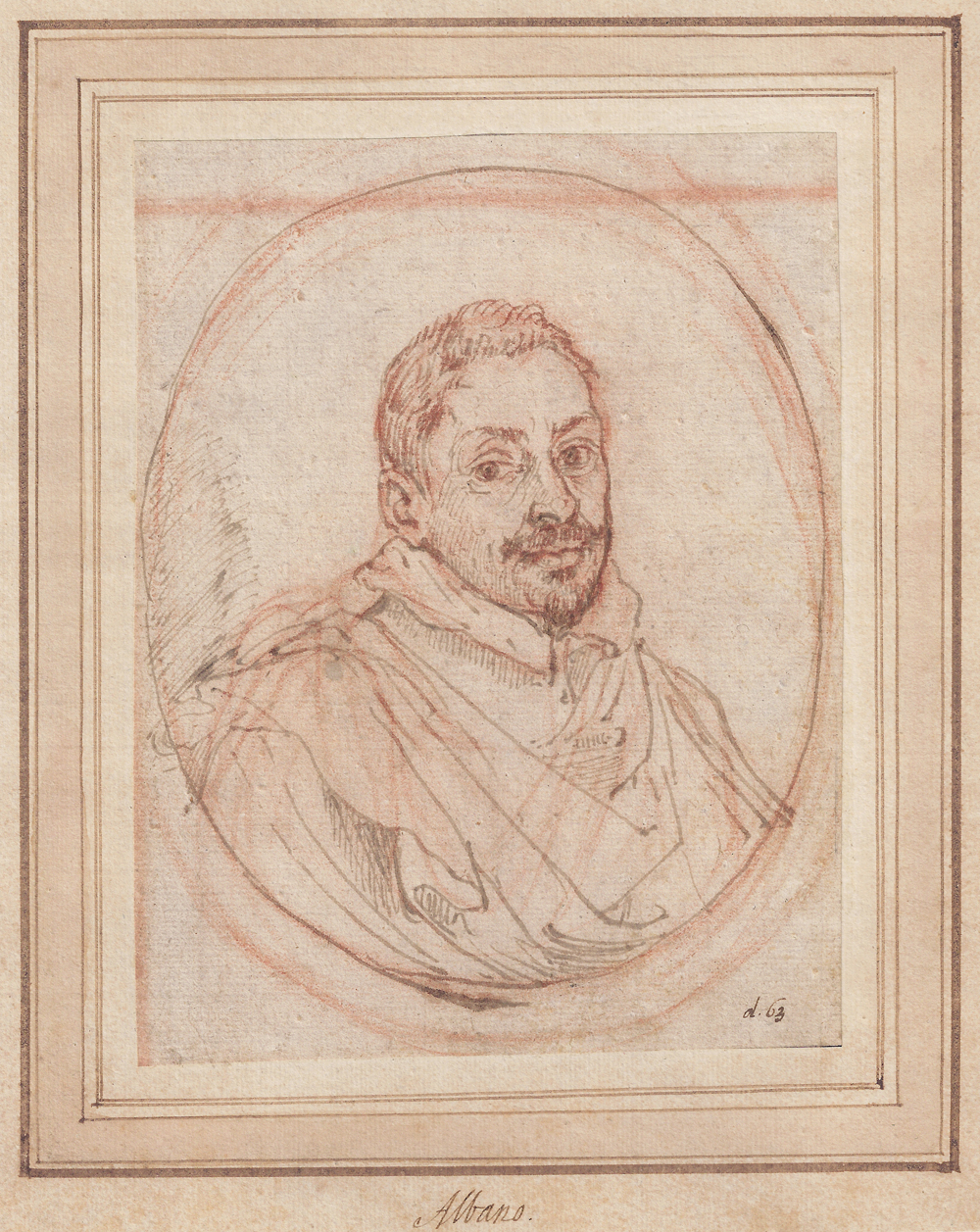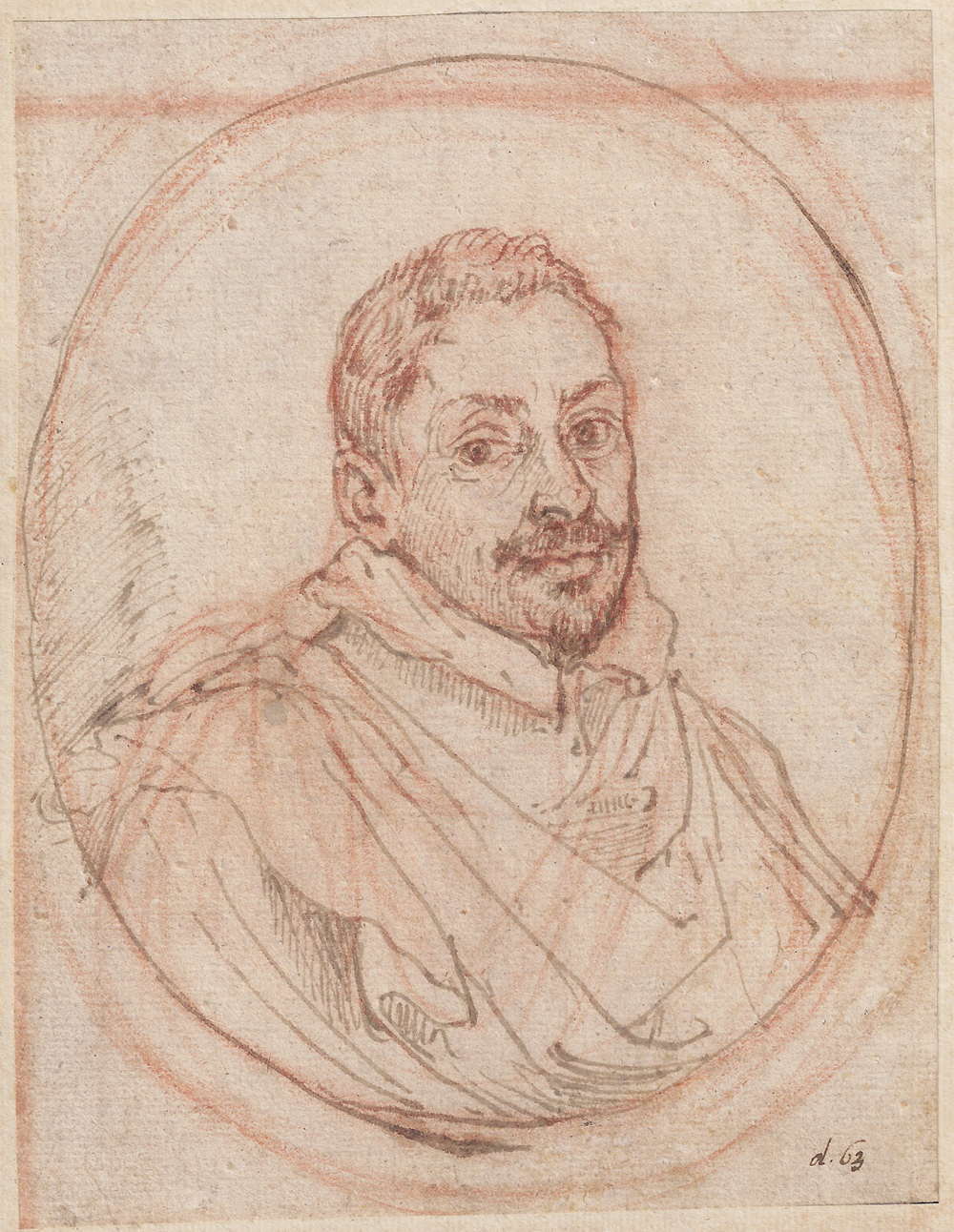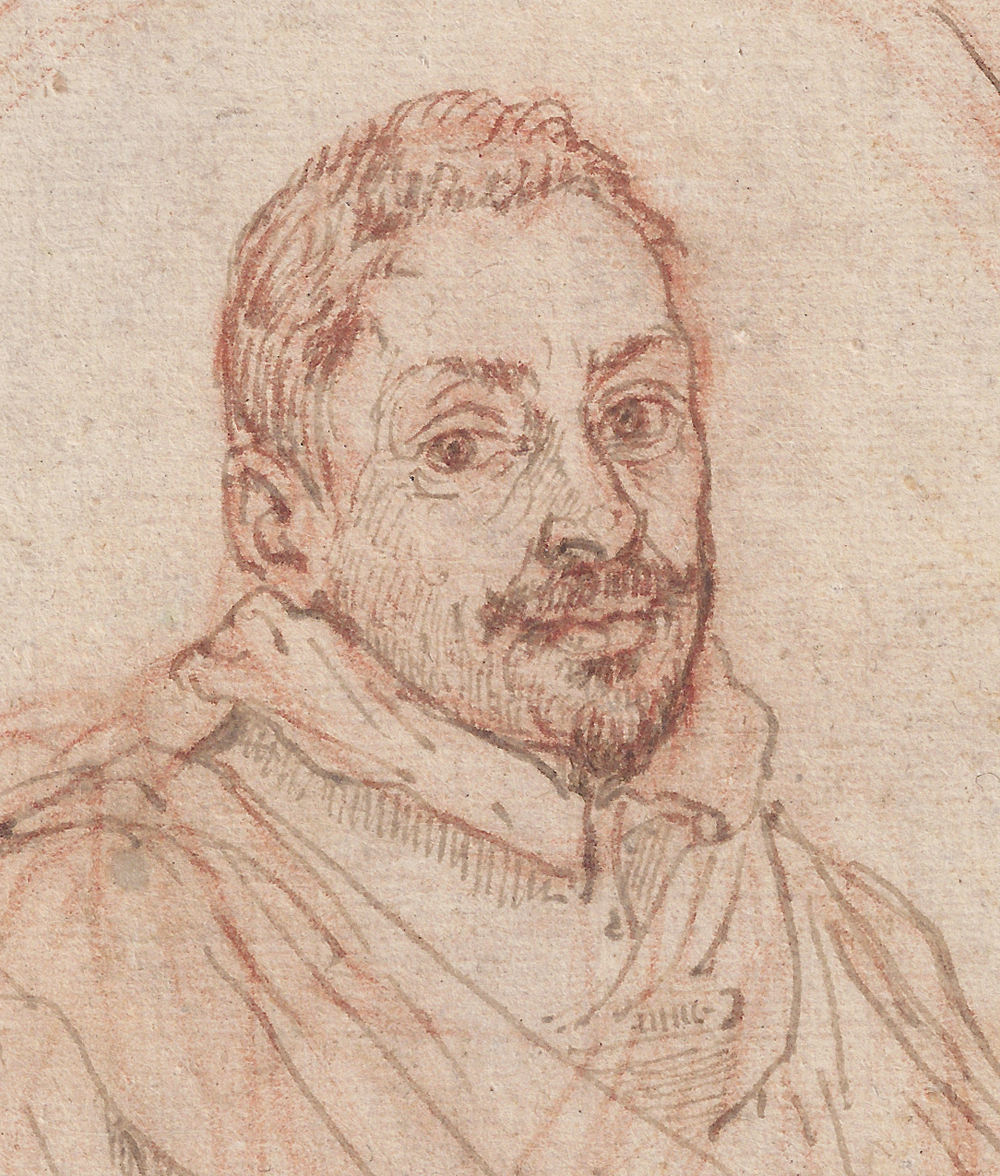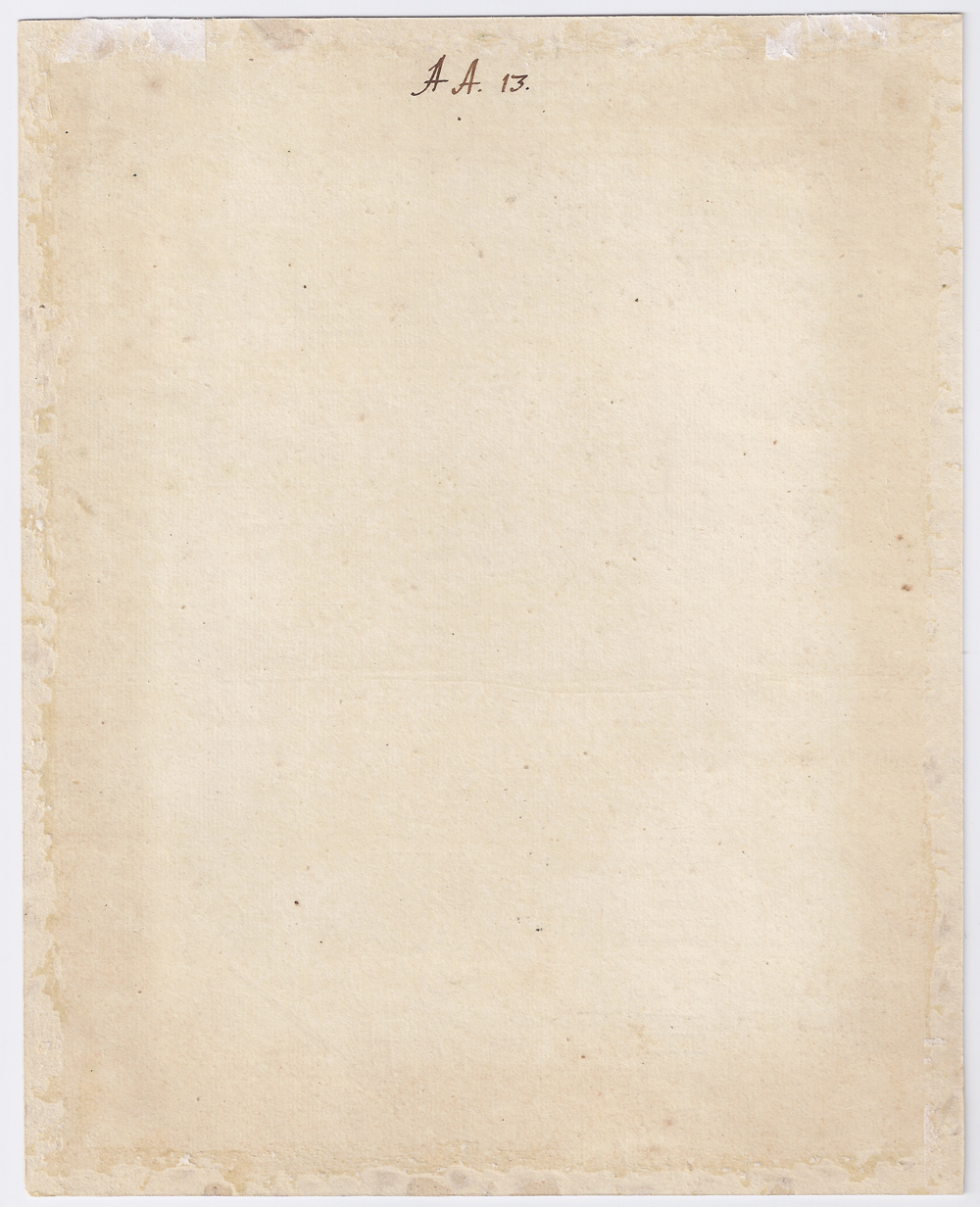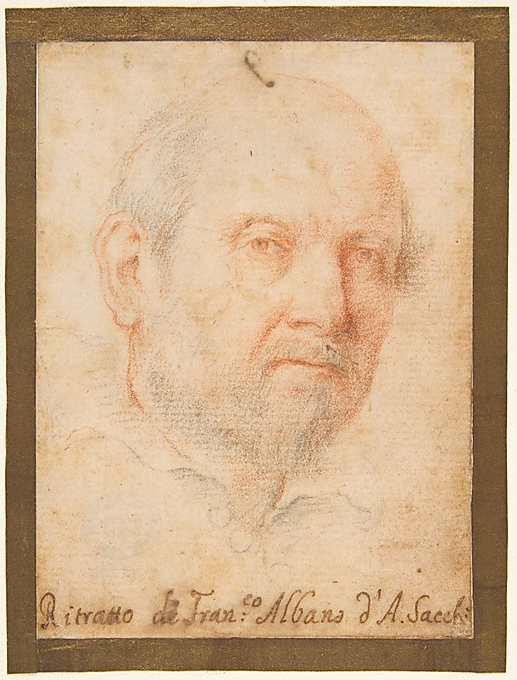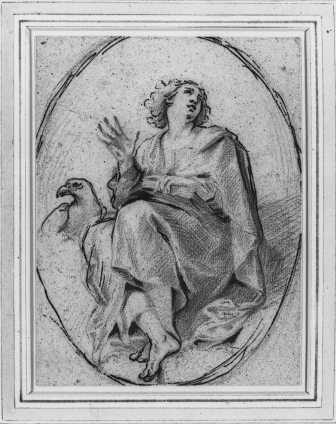FRANCESCO ALBANI (Bologna 1578 – 1660 Bologna)
Francesco Albani (Bologna 1578 – 1660 Bologna)
Portrait of a Man, possibly a self-portrait
Pen and grey-brown ink over red chalk, in a drawn oval, 178 x 136 mm (7 x 5.3 inch); laid down on Richardson’s mount with framing lines in pen and brown ink and brown wash, 240 x 190 mm (9.4 x 7.5 inch)
Bears Lord John Somers’s numbering in brown ink, lower right 'd.63'; and Richardson’s shelf number on the verso of the mount 'AA. 13'.
Provenance
~ Padre Sebastiano Resta (1635-1714)
~ Giovanni Matteo Marchetti, Bishop of Arezzo (d. 1704)1
~ John, Lord Somers (1650-1716) (Lugt 2981, with his numbering lower right: d.63)
~ Jonathan Richardson, Senior (1665-1745) (on the remains of his mount, with his attribution Albano and his shelf number on the back: AA. 13.)
~ Ray Livingston Murphy, Park Avenue, New York (1923-1953)
~ Sold from his estate, London, Christie's, 12 December 1985, lot 1672
~ Purchased at the above sale by Ralph Holland (1917-2013), until 2013
***
In contrast to the hundreds of surviving sheets by the Carracci and by such pupils and followers as Domenichino, Guido Reni and Guercino, no major corpus of drawings by the Bolognese artist Franceso Albani has come down to us.3 This is all the more surprising given Albani’s role as a succesful and popular teacher with an unusually large complement of pupils, and as a moving force in the establishment of an Accademia del Disegno in Bologna in the 1640s and 1650s, the main activities of which seem to have been life drawing and drawing competitions. One would have expected drawing to have been a core activity in his studio, from which emerged such talented draughtsmen as Andrea Sacchi, Pier Francesco Mola, and Carlo Cignani. Moreover, in most respects Albani was a firm adherent of the traditions established by the Carracci in their native city, one of the strongest and most enduring of which was the empahsis on good draughtsmanship and the centrality of its role in all aspects of artistic creativity.
It is certainly true that very few of the published drawings by Albani date from the later part of his career, indicating that he may have made fewer drawings as he got older. What seems clear is that no large body of drawings by Albani was kept together in his studio for future reference or as a teaching resource.
The twelve-year old Francesco Albani began his studies in the Bolognese studio of the Flemish-born painter Denys Calvaert, after which he transferred around 1595 to the Carracci Accademia degli Incamminati, where life drawing predominated. His first public commissions were obtained through Ludovico Carracci, closely resembling his master’s manner. In 1601 Albani moved to Rome with his close friend Guido Reni, remaining there until 1617, when he returned to Bologna. Albani’s main achievement during these years were small cabinet pictures on copper illustrating devotional or mythological subjects in the classical manner. Albani’s Bolognese studio rivalled Reni’s for the most important public commissions, and attracted many pupils.
The entry for our drawing in the Lansdowne manuscript of the Resta-Somers collection held at the British Museum reads as follows: Di Fran:co Albano quando seguitiva Annibale / M'era parso d'Ag.o Carracci, poi d'Ant.o Scalvati, ma / riveduto in altro libro il disegno del Ritratto dell'Albano / fatto da lui med.o l'ho ascritto a lui ma non si dovra / imputar ad arrore, se si terra per d'Agostino o d'Annibale. (By Francesco Albano when he followed Annibale. Firstly I believed it to be by Agostino Carracci, then by Antonio Scalvatti, but having found in another book a portrait of Albano made by himself, I have attributed it to him but one would not be mistaken to consider it to be by Agostino or Annibale.).4 Resta’s thoughts on the authorship of our drawing are fascinating, and illustrate how the great collector kept revising and adjusting his attributions.
The drawn self-portrait which Resta mentions appears to be lost, but several documented likenesses of Albani are known:5 a painted self-portrait of 1638-38 is in the Pinacoteca Nazionale, Bologna, and a portrait in oils by Andrea Sacchi dated 1635 is in the Prado, Madrid; a further drawn portrait by Sacchi, identified as Albani at early stage, is preserved in the Metropolitan Museum, New York (fig.).6 All these show the artist in more advanced years. His likeness was also recorded by Malvasia in 1678, a ‘handsome young man, vigorous in maturity, and venerable in old age; he had a soft, delicate and light complexion, and a noble bearing, with a solemn and stately mien. He was average in height, somewhat corpulent, but well-built and athletic.’7 Our drawing certainly makes the impression of an informal portrait, and the intense look of the sitter has the appearance of a self-portrait. Although it is difficult to be certain, the slight resemblance of the sitter to the later portraits of Albani might indicate it is indeed a self-portrait, as Resta believed.
A drawing by Albani showing similar fast handling and executed in the same technique, depicting St John the Evangelist with his Eagle, is preserved in the Royal Collection at Windsor (fig.).8
SOLD
1. Giovanni Matteo Marchetti was the borrower and part purchaser of Padre Sebastiano Resta’s collection of Old Master drawings. Marchetti’s appearance is recorded: he is shown seated at a table in a palace loggia in a large and celebrated drawing by Passeri at Chatsworth, commemorating his acquisition of Resta’s collection on 25 April 1698; Resta, accompanied by servants, brings him the albums, which the bishop discusses with his nephew, the Cavaliere Marchetti of Pistoia, who stands at his side.
2. In the Christie's sale, it was noted that this and other drawings from Murphy's collection were removed from an album which had been assembled in England in the mid-18th century and which contained many drawings from the collection of Jonathan Richardson, Senior, perhaps bought at his sale in 1747.
3. For Albani as a draughtsman, see A. Sutherland-Harris, ‘Some Chalk Drawings by Francesco Albani’, Master Drawings, VII, 1969, pp. 152-55; N. Turner, ‘Some Thoughts on Francesco Albani as a Draughtsman’, in: A. Morrogh (ed.), Renaissance Studies in Honor of Craig Hugh Smyth, Florence 1985, vol. I, pp. 493-500; and A. Weston-Lewis, ‘Francesco Albani disegnatore: some additions and clarifications’, Master Drawings, XLIV, 2006, pp. 299-332.
4. Scalvati was a pupil of Passerotti who moved to Rome and worked in the Vatican, and painted portraits of several Popes. Nothing is known of his drawings, but it is interesting that Resta even proposed his name.
5. For a discussion of these, see C.R. Puglisi, Francesco Albani, New Haven 1999, p. 169.
6. Jacob Bean and Lawrence Turcic, 17th century Italian Drawings in The Metropolitan Museum of Art, New York 1979, cat. no. 345, fig. no. 345, p. 262, repr.
7. Puglisi, loc. cit.
8. Pen and brown ink and red chalk, 226 x 172 mm; inv. no. RL 5672; see Turner, op. cit., pp. 493-98.
